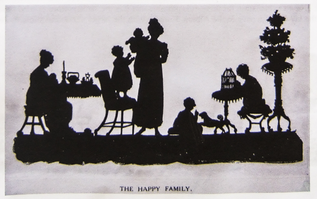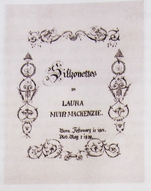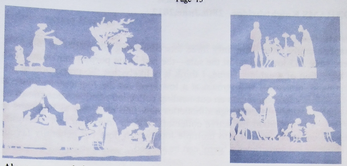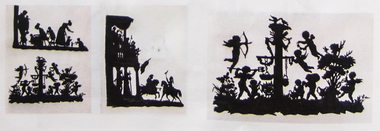Mackenzie, Laura Jemima Muir (SCC Newsletter September 2012)
Laura Jemima Mackenzie. b. 12.2.1801 - d. 2.5.1828.
A recorded ‘cutter' of silhouette pictures—only known album of her work was sold at a recent sale.
 The work of this artist may be known to many of you from the small card illustrated above. This is printed by the V. & A. Museum from their Collection—the original is 10" X 8" in size. However, I doubt if any of you have had an opportunity to acquire any of her pictures—as it is likely, with a few exceptions that have been removed from the album, that her entire output is in the album the sale of which has prompted this article.
The work of this artist may be known to many of you from the small card illustrated above. This is printed by the V. & A. Museum from their Collection—the original is 10" X 8" in size. However, I doubt if any of you have had an opportunity to acquire any of her pictures—as it is likely, with a few exceptions that have been removed from the album, that her entire output is in the album the sale of which has prompted this article.
References to the artist in the silhouette literature.
Desmond Coke in the "Art of Silhouette" published in 1913 mentions her work on page 126, when he is writing about "fancy subject albums". He considered her album to he the most charming one he had seen. Then he went on to describe briefly the variety of her work and to illustrate an example. Mrs. N. Jackson has a very brief entry in her "Dictionary" published in 1938—mentioning that the V. & A. had several of her works, which she did not consider to be of first quality! Also, she had seen a work dated 1806, which is unlikely as the artist would only have been five years old. R. L. Megroz in "Profile Art" published in 1948 also refers to her cut-out work in the V. & A. Collection and illustrates the picture at the top of this page.
It is as a result of these three references that Mrs. McKechnie has an entry in her Book in Section Two on page 253. In this she gives some detail of the artist's background, but at the time was not able to establish her dates of birth and death. She noted the variety of her work & her modus operandi. Also, she illustrated the picture above on page 330 (illus. 527)
Since the sale of the album I have found further family details from an old Scottish newspaper on the Internet. I am sure other information may be out there if one had the time!
Page 13
Personal & Family History.
Laura was the third daughter of Sir Alexander Muir Mackenzie Bart and Lady Jane Muir Mackenzie, who married in September 1787 and whose family seat was Delvine in Perthshire. From newspaper references her father seems to have been a very prominent citizen in the area—both interested in politics and social life & charities. Her mother was the eldest daughter of Sir Robert Murray Bart and she seems to have been made a Dame at some point.
From the Album we know that Laura was born on 12th. February, 1801—so it is unlikely that Mrs. Jackson had the right date of 1806 for one of her pictures. She died on 2nd May, 1828 at the age of twenty-seven. Her mother had died the year before on 22nd May 1827—her youngest sister Amelia Euphemia had died on 19th. June, 1825 and another sister Elizabeth Jane was to die in July, 1829 on the Isle of Wight. It is unlikely that any of the three sisters would have been over forty and at least two would have been very much younger. Laura is buried in the family vault at Delvine.
Below I have illustrated the picture from Desmond Coke's "The Art of Silhouette". It is entitled "The Happy Family" and is recorded as being cut in 1810. However, this date is difficult to take on board as Laura would have been only nine years old at the time—I doubt very much that a child of that age could have achieved this amount of detail, quite apart from thinking-up the subject matter.
Her Work.
Most of her work is of domestic scenes—showing women and children either playing games, bathing babies, combing hair or stroking dogs. It has been suggested that the figures are likely to be of relatives or friends of the family. Also, it is noted, especially by Desmond Coke, that the artist seemed to be ‘preoccupied' with the little fellow called Cupid! I quote "Cupid is supreme" - he then adds that cupid is either burning vast sackfuls of hearts in a great cauldron on a bonfire or he is sitting on the chair of a damsel who is writing to her swain, when he (Cupid) is quite prepared with his bow to shoot her down without remorse! She cut other scenes not of a domestic nature as can be seen on the next page—the V. & A. have a work entitled "The Stag Hunt" It is doubtful if any of her works were printed in her lifetime.
Page 14
The Album & Her Style.
 The Album was sold at Dreweatts Auction House at Donnington Priory on 21st. March. 2012 (Lot 123) It consisted of thirty pages and was just under 10" X 7.75" in size - some pages contained one picture and others as many as seven. At the end of the Album were a number of pencil and watercolour sketches plus a miniature of a young girl said to be "Aunt Laura” (presumably the artist). It made £3,200 on the hammer (est. 1,000—1,500).
The Album was sold at Dreweatts Auction House at Donnington Priory on 21st. March. 2012 (Lot 123) It consisted of thirty pages and was just under 10" X 7.75" in size - some pages contained one picture and others as many as seven. At the end of the Album were a number of pencil and watercolour sketches plus a miniature of a young girl said to be "Aunt Laura” (presumably the artist). It made £3,200 on the hammer (est. 1,000—1,500).
The pictures varied in form—some were cut with blackened paper on a white ground—others were cut with white paper on a Wedgewood blue background representing a Wedgewood type plaque. All were cut from a single sheet of paper—the artist leaving a broad strip at the base of each. Where signed the signature was either on the reverse or on the obverse near the base. The signature being either her full name Laura Jemima Muir Mackenzie or just L,. M. Mackenzie. Whether she did any pre-drawing before cutting we do not know.
I have illustrated above the frontispiece of the Album, which gives her dates of birth and death. Below I have illustrated from the Sale catalogue some of her pictures cut from black paper. You will note that two pictures are the same—but reproduced in a different size. I cannot give an explanation for this—it is possible that it is the same picture printed twice to show the lay-out of a page in the Album. Equally with the larger version to show more detail.

Page 15
Above are several pictures with a Wedgewood blue background—these are from two pages in the Sale catalogue.
The miniature illustrated below is something of a mystery. It is not likely that this is by the artist, but it clearly relates to her from the pencil name "Aunt Laura" on the reverse. It is equally unlikely that there was another Laura in the Muir Mackenzie family—also if there was another Laura why would a portrait of her be put into the Album? Therefore assuming that this is a portrait of Laura the silhouette artist—why is she painted without hands and with her arms ending in stumps? Also, the background of the portrait is rather strange—this adds further to the mystery Is it an unfinished work—if so would the hands be left out in this way? Any suggestions would be welcomed! Are her hands in water?
We know it is possible for people with no hands to do extraordinary things such as embroidery, leather work and painting, but is it possible to cut such detailed and intricate pictures? We have the example of Miss Honeywell—nineteenth century American silhouette artist, who had no hands. However, I think her work could be described as somewhat clumsy compared to that of Laura—although collectors of her work would probably take issue with me!
Laura Muir Mackenzie was from a privileged background—rather similar in many ways to that of Lady Louisa Kerr. Both did not have to earn their living, but were talented artistically. Unfortunately Laura had short life compared with Louisa and this is reflected in their respective outputs. My thanks to Cynthia McKinley of “Wigs on the Green” a member of the S.C.C. for drawing my attention to the Dreweatts Sale.






